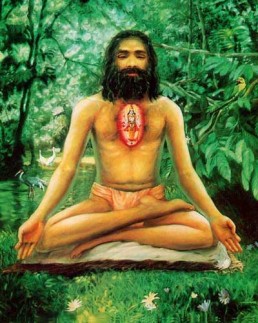तत्स्थतदञ्जनता समापत्तिः ॥ १.४१॥
tatsthatadañjanatā samāpattiḥ .. 1.41..
Patanjali Yogasutra Introduction
Part 1 – Samādhi-pāda – Yoga and its Aims
1.1
1.2
1.3
1.4
1.5
1.6
1.7
1.8
1.9
1.10
1.11
1.12
1.13
1.14
1.15
1.16
1.17
1.18
1.19
1.20
1.21
1.22
1.23
1.24
1.25
1.26
1.27
1.28
1.29
1.30
1.31
1.32
1.33
1.34
1.35
1.36
1.37
1.38
1.39
1.40
1.41
1.42
1.43
1.44
1.45
1.46
1.47
1.48
1.49
1.50
1.51
Part 2 – Sādhana-pāda – Yoga and its Practice
2.1
2.2
2.3
2.4
2.5
2.6
2.7
2.8
2.9
2.10
2.11
2.12
2.13
2.14
2.15
2.16
2.17
2.18
2.19
2.20
2.21
2.22
2.23
2.24
2.25
2.26
2.27
2.28
2.29
2.30
2.31
2.32
2.33
2.34
2.35
2.36
2.37
2.38
2.39
2.40
2.41
2.42
2.43
2.44
2.45
2.46
2.47
2.48
2.49
2.50
2.51
2.52
2.53
2.54
2.55
Part 3 – Vibhūti-Pāda – Powers
3.1
3.2
3.3
3.4
3.5
3.6
3.7
3.8
3.9
3.10
3.11
3.12
3.13
3.14
3.15
3.16
3.17
3.18
3.19
3.20
3.21
3.22
3.23
3.24
3.25
3.26
3.27
3.28
3.29
3.30
3.31
3.32
3.33
3.34
3.35
3.36
3.37
3.38
3.39
3.40
3.41
3.42
3.43
3.44
3.45
3.46
3.47
3.48
3.49
3.50
3.51
3.52
3.53
3.54
3.55
3.56
Part 4 – Kaivalya-pāda – Liberation
4.1
4.2
4.3
4.4
4.5
4.6
4.7
4.8
4.9
4.10
4.11
4.12
4.13
4.14
4.15
4.16
4.17
4.18
4.19
4.20
4.21
4.22
4.23
4.24
4.25
4.26
4.27
4.28
4.29
4.30
4.31
4.32
4.33
4.34

Commentary on Sri Patanjali Yogasutra by Swami Vivekananda
What results from this constant meditation? We must remember how in a previous aphorism Patanjali went into the various states of meditation, how the first would be the gross, the second the fine, and from them the advance was to still finer objects. The result of these meditations is that we can meditate as easily on the fine as on the gross objects. Here the Yogi sees the three things, the receiver, the received, and the receiving instrument, corresponding to the Soul, external objects, and the mind. There are three objects of meditation given us. First, the gross things, as bodies, or material objects; second, fine things, as the mind, the Chitta; and third, the Purusha qualified, not the Purusha itself, but the Egoism. By practice, the Yogi gets established in all these meditations. Whenever he meditates he can keep out all other thoughts, he becomes identified with that on which he meditates. When he meditates, he is like a piece of crystal. Before flowers the crystal becomes almost identified with the flowers. If the flower is red, the crystal looks red, or if the flower is blue, the crystal looks blue.
Yogasutra – Verse 1.41 – Yogasutra-1.41-kṣīṇavṛtterabhijātasyeva – In Sanskrit with English Transliteration, Translation, Meaning and Commentary by Swami Vivekananda – Yogasutra-1-41
